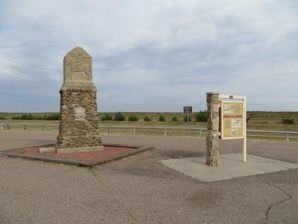Trails West
Smoky Hill Trail
The Smoky Hill Trail was the most direct route to Denver and the goldfields of the central Rockies. Immigrants heading west through central Kansas followed the Kansas River, then headed up its Smoky Hill River branch into the high plains of eastern Colorado. Here, the Smoky Hill River ended. Immigrants then turned northwest to Denver over the high, dry rolling prairie country. It was a tough stretch. A Denver newspaper called those who dared it "foolhardy and insane." With full-scale Indian-white wars of the mid-1860s, the trail was extremely dangerous. Still, the Butterfield Overland Stage served the route, and later the Kansas Pacific Railroad built along the trail's ruts.
Cheyenne Wells Stage Stop
Bayard Taylor, a famed adventurer and writer, traveled by stagecoach on the Smoky Hill Trail in the summer of 1866. This is his report of conditions at the Butterfield stage stop at Cheyenne Wells, Colorado: "We found a large and handsome frame stable for the mules, but no dwelling. The people lived in a natural cave, extending for some thirty feet under the bluff. But there was a woman, and when we saw her we augured good fortunes. Truly enough, under the roof of conglomerate limestone, in the cave's dim twilight, we sat down to antelope steak, tomatoes, bread, pickles, and potatoes--a royal meal, after two days of detestable fare."




